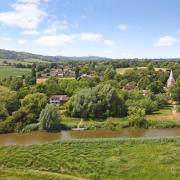September is rather a lovely time in the garden as hot borders really come into their prime, the glorious bursts of colour mingling together as on an atmospheric impressionistic canvas.
The showiest colour and impact arguably comes from dazzling dahlias which have seen a real resurgence of popularity and are valued for the sheer impact they have in the garden from June through to the first frosts, as well as cutting for the vase. Impressive planted en masse with a dazzling array of colours jostling together for attention, or as part of a mixed planting scheme, dahlias erupt on the late summer and autumn scene with great flamboyance. There is such a wide variety that enjoys a starring role in the late season garden, making for a real feast to discover.

Dahlias come in an array of colours, varying flower sizes and shapes, multi-coloured blooms or the stylish dark foliage forms. Growers across the world continue to introduce further variations of novel and fashionable combinations to keep up with the trends. A member of the Asteraceae family, there are around 36 species of dahlias, with thousands of various cultivars and hybrids. Skilled breeders across the world have produced a wide range of sizes and colours practically unmatched in the world of flowers. Dahlias can be described as decorative, cactus, anemone, waterlily, pompon, balls, collarette, dwarf, peony or orchid. Sizes range from the smallest lilliput to dinnerplate-sized blooms and there is every colour except for that most elusive colour for breeders – blue.

With dahlias at their peak of impact now, it’s a great time to see the sheer variety on offer and to inspire ideas for combining them in your garden with other late bloomers. Begin your inspiration tour at the iconic Great Dixter in Northiam, important as the instigator for the great popularity of dark foliaged dahlias, started by the late Christopher Lloyd when in 1993 he famously pulled out his rose garden and replaced it with an exotic border starring ‘The Bishop of Llandaff’ against towering cannas. Today dahlias continue to play a dynamic role in the late season displays. The trend for dark foliage continues with the Bishop series and ones such as the very popular ‘David Howard’. A resurgence for bright, cheerful colours has also seen mass-planted seas of all kinds of dahlias as a crescendo to the season. In the cutting garden area of West Dean’s restored walled garden the impact is clear as dahlias fill the beds against ribbons of asters and other perennials. They also bring vibrant colour to the borders in this famous garden.

There are also some lovely private gardens, which open this month through the National Garden Scheme, where dahlias are woven through the beds and borders in thought-through, orchestrated combinations, offering us further take-home ideas. Deep cerise dahlias with purple, mauve and blue accompanying perennials create richly toned borders at Knighstbridge House in Hellingly. Ornamental grasses make ethereal foils here, and also at Sandhill Farm House, home to the renowned garden designer, writer and founder of the English Gardening School, Rosemary Alexander, where dahlias feature masterfully in the different garden rooms. As well as recognised varieties in blowsy combinations with plants that thrive in similar conditions, Rosemary likes to discover new types, such as rarely seen small species dahlias. My final stop on our dahlia tour is at Limekiln Farm at Chalvington where casual groupings of dahlias mix with easy-care asters, heleniums and cleome in the borders.

Get the look
• Dahlias need a sunny spot, protected from strong winds, in rich, moist, well-drained loamy soil but not wet, waterlogged soils
• Plant tubers once frosts have passed, allowing about eight weeks to the start of flowering
• Tubers can be purchased through mail order, in packets at nurseries or you may be able to scrounge some from a kind friend who has divided their clump of tubers
• Ensure that each piece has some stem and at least one of the buds or ‘eyes’
• Dig a hole about 30cm deep, add in some compost or manure and wet with a watering can of water
• Tall-growing dahlias will need staking and it is a good idea to position the stake at planting
• Unless the soil is very dry, don’t water until they’ve grown about 15 centimetres, to avoid the tuber rotting
• As they grow pinch out the growing tips to promote bushy growth
• Protect from slugs and snails and deadhead regularly to keep the plant flowering for as long as possible
• After the season is finished cut back to ground level, mulch deeply if leaving in the ground in mild areas, or lift, wash, leave to dry then wrap in newspaper or in wood shavings and store somewhere frost and damp free
• In very free-draining soil leave the stems to go black from the first frost for approximately a fortnight to allow the sugars to go back down the stems to feed the tuber. Then cut the stems off just below ground level, mound up the soil or add compost to protect the tuber over winter
• In poorly-drained or clay soil, at the first frost cut them down by half and then lift the tubers
• There are so many – from bee-friendly single, daisy-like flowers, tiny round pompons and bi-coloured frilly collarettes, to firework spectacular cactus shapes
• Being perennials they work well mixed with other robust perennials, happily mingling with contrasting opulent autumnal plants or blending the tones for harmonious effects
• Most grow to large bushes so taller plants such as eupatorium, agapanthus and buddleias work as a backdrop and ensure any smaller foreground plants can cope with being shaded by their leaves
• In a cutting garden, decorative and cactus dahlias in particular are the ideal cut-and-come-again flower because they flower for months on end

Did you know?
• Dahlias originate in the mountains of Mexico, Columbia and Guatemala and were first recorded by Westerners in 1615.
• They are named after the Swedish botanist, Dr Anders Dahl, who originally regarded it as a vegetable rather than a garden flower. In fact scientists even looked at the dahlias as a food source following the destruction of the French potato crop by a disease in the 1840’s. However after tasting the tubers they soon changed their minds!
• Their beauty has been much admired since the development of varieties with large, double blooms were bred in Belgium in 1815. In a few short years nearly every colour that we know today had been introduced and there were hundreds listed in catalogues for plant-obsessed gardeners of the time.
To know
• Great Dixter House and Gardens, Northiam, TN31 6PH
Open Tues to Sun and BHM (11-5)
Web: greatdixter.co.uk
• West Dean Gardens, West Dean, PO18 0RX
Open daily (9-5)
Web: westdean.ac.uk
National Garden Scheme, Web: ngs.org.uk
• Knightsbridge House, Hellingly, BN27 4HH
Wed 6, Sat 9 Sept (2-5)
Adm £7, chd free, home-made teas
• Sandhill Farmhouse, Rogate, GU31 5HU
Sat 16, Sun 17 Sept (2-5)
Adm £5, chd free, home-made teas
• Limekiln Farm, Chalvington, BN27 3TA
Sat 23, Sun 24 Sept (2-5)
Adm £7, chd free, home-made teas



























